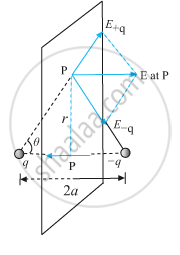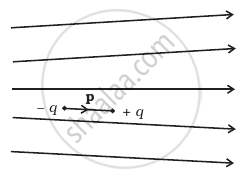Advertisements
Advertisements
प्रश्न
Answer the following question.
Derive an expression for the electric field due to a dipole of dipole moment `vec"p"` at a point on its perpendicular bisector.
उत्तर

The magnitudes of the electric field due to the two charges +q and −q are given by,
`E_(+q) = ("q")/(4πε_0) (1)/("r"^2 + a^2)` .....(i)
`E_(-q) = ("q")/(4πε_0) (1)/("r"^2 + a^2)` .....(i)
∴ `E_(+q) = E_(-q)`
The directions of E+q and E−q are as shown in the figure. The components normal to the dipole axis cancel away. The components along the dipole axis add up.
∴ Total electric field
`E = -(E_+q + E_-q) cos theta hat"p" ... ["negative sign shows that field is opposite to" hat"p"]`
`E = -(2qa)/(4πε_0("r"^2 + a^2)^(3/2)) hat"p"` ....(iii)
At large distances (r >> a), this reduces to
`E = -(2qa)/(4πε_0"r"^3)hat"p"` ....(iv)
∵ `vec"p" = q xx vec"2a"hat"p"`
∴ `E = (-vec"p")/(4πε_0"r"^3)` ...(r>>a).
APPEARS IN
संबंधित प्रश्न
Why do the electrostatic field lines not form closed loops?
Why do the electric field lines never cross each other?
(a) Derive an expression for the electric field E due to a dipole of length '2a' at a point distant r from the centre of the dipole on the axial line.
(b) Draw a graph of E versus r for r >> a.
(c) If this dipole were kept in a uniform external electric field E0, diagrammatically represent the position of the dipole in stable and unstable equilibrium and write the expressions for the torque acting on the dipole in both the cases.
A point charge (+Q) is kept in the vicinity of an uncharged conducting plate. Sketch the electric field lines between the charge and the plate?
Two bar magnets are quickly moved towards a metallic loop connected across a capacitor ‘C’ as shown in the figure. Predict the polarity of the capacitor.

Explain why two field lines never cross each other at any point?
Figure shows electric field lines in which an electric dipole P is placed as shown. Which of the following statements is correct?

Which of the following figures represent the electric field lines due to a single negative charge?
The magnitude of the electric field due to a point charge object at a distance of 4.0 m is 9 N/C. From the same charged object the electric field of magnitude, 16 N/C will be at a distance of ______.
